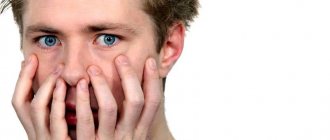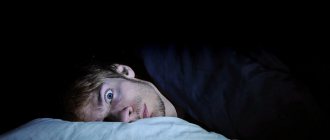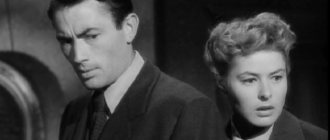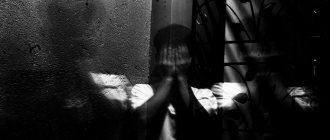Aichmophobia (less commonly, oxyphobia) is a difficult-to-control fear of sharp objects. This phobia may be mistakenly associated with forms of obsessional neurosis, but such a classification is groundless. Aichmophobia is precisely the “fear of the edge”, which is paroxysmal in nature and is often not accompanied by a general increase in anxiety.
The object of a phobia can be:
- broken glass;
- sharp cutlery;
- sharp instruments;
- sewing supplies;
- office supplies (pins, buttons, sometimes even paper clips).
If aichmophobia is a symptom of another disorder, then very grotesque forms of the disease can develop: for example, fear of any corners (tables, doorways, etc.); If we still talk about obsessive-compulsive neurosis, then oxyphobia can be included in its structure, but such a diagnosis requires symptoms unique to such a disorder. The most “popular” objects of fear in aichmophobia are knives and needles.
Causes of fear
Oxyphobia is a unique fear, although not uncommon in clinical practice.
Firstly, this phobia is absolutely not related to heredity. Secondly, the reasons for the development of fear of sharp objects are most often directly related to a traumatic situation: we are afraid of sharp objects because we had an unpleasant experience of interacting with something. As a rule, this phobia develops after injury with a sharp object, but later (in rare cases, the disease may disappear over time) it turns into a normal form of human behavior aimed at avoiding danger.
An analogy can be drawn with the fear of dogs after a bite: after some time (sometimes 2-3 years), the fear disappears by itself. In general, this is a peculiar form of the instinct of self-preservation, but in the case of aichmophobia it is greatly exaggerated.
Despite the direct connection between trauma and phobia, fear can be delayed. For example, the roots of oxyphobia can be laid in childhood and manifest themselves at the age of 16-20 years. A glass broken in childhood or a leg pierced by a nail may come back to haunt you in a somewhat similar situation in the future. However, at a conscious age, fear is more likely to arise (especially since there is a basis for it) rather than immediate coping with it through crying or other defensive behavior. – let’s call this scenario for the development of fear of sharp objects conditionally normative.
Then the question arises about the non-normative development of fear. As a rule, oxyphobia in this case develops in the picture of PTSD (post-traumatic stress disorder). Its development may be determined by:
- intentionally inflicted injury (attempted murder);
- accidents (severe injury and amputation of limbs at work, in accidents);
- suicide attempts (using cuts) made under the influence of passion;
- death of relatives due to the above reasons.
In this case, oxyphobia is a symptom and it is necessary to carry out comprehensive and long-term rehabilitation of PTSD: only in this way will it be possible to get rid of the accompanying disorders.
So, now briefly about the epidemiology of oxyphobia. Surprisingly, the disease is more common in women, although the injury rate in men is higher. The “golden” period of manifestation of the disease is the period from 20 to 50 years for both sexes.
What it is?
In ancient times (where the name of this disease comes from), agoraphobia was called “fear of marketplaces.” In current realities, the understanding of this phenomenon has transformed into a “fear of open space.” For this type of phobia, separate points are allocated (with and without panic disorder) in the international classification of diseases, so that the phobia can fully be considered a mental disorder, and not an eccentricity of an individual.
The word “fear” can mean various things, united by the central concept of fear. What does psychiatry and psychology mean in the concept of phobia?
A phobia in the sciences of the human psyche is an obsessive state of fear caused by a specific object, phenomenon or circumstance. The main difference between a phobia and anxiety is objectivity, i.e. belonging to a specific object.
Another characteristic sign of a phobia is the disproportion of the experienced horror to the object that causes it. As a rule, clients suffering from phobias are well aware that the object that frightens them is completely harmless (as is the case with open spaces), but they cannot do anything about the unconscious fear they feel when confronted with this object, its mention or even thoughts about him.
Often, a phobic disorder is accompanied by panic attacks - attacks of somatic manifestation of fear in a situation of collision with a frightening object. Thus, agoraphobes, finding themselves in an open space, may experience:
- strong heartbeat;
- breathing problems;
- tremors or sweating;
- obsessive thoughts about death or imminent loss of reason.
These manifestations can be so strong that a panic attack can result in loss of consciousness or a hysterical attack with convulsions. In this case, a person can be completely healthy physically (in terms of blood vessels, heart, epileptic seizures, etc.).
Symptoms of pathological fear
Phobia attacks can occur at varying frequencies, from several times a day, or to be absent for several months. The frequency and severity of attacks are influenced by the general psychological state of the patient, his life circumstances, and general health.
Subsequently, social maladjustment and vulnerability sets in. At this time, the instinct of self-preservation is activated, and aggression or hysteria may occur. The patient tries with all his might to avoid contact or mention of a dangerous object. A panic attack may give way to a hysterical attack.
Symptoms of an attack of aichmophobia:
- cardiopalmus;
- acceleration of pulse and breathing;
- tinnitus;
- pale skin and cold sweat;
- fever or suffocation;
- feeling of heaviness and physical discomfort;
- uncontrolled movements of the limbs;
- dizziness;
- desire to run away or hide;
- aggression (indignation) or hysteria.
If there are four or more symptoms when seeing or mentioning sharp objects, we can talk about the presence of aichmophobia.
Symptoms of pathological fear of sharp objects do not bring comfort to the life of either the patient with aichmophobia or those around him, which can have extremely negative consequences of various kinds. This disease requires complex treatment with the involvement of specialists.
During an attack, the patient may experience ringing in the ears
Symptoms
Oxyphobia is a periodically manifested disease. The paroxysmal course can be associated with various factors: from a real threat to excessive fatigue of the nervous system. The main manifestation is short-term outbreaks (in the “pure” case they do not exceed 10 minutes) of acute fear, which can turn into a panic attack. The frequency of their manifestation is unique - from several times a week to once every few months.
It is the frequency and strength of a panic attack that can conditionally determine the depth of the disorder and the need for its specialized treatment.
A panic attack is accompanied by disturbing images in a person’s imagination, and with strong and uncontrollable attacks (which do not happen so often), a state of maladjustment in place and time may occur. Severe attacks may be accompanied by open flight from a dangerous situation.
Of course, in the case of a real threat, sharp objects cause understandable fear in a healthy person (instinct of self-preservation), but it is worth distinguishing such conditions from obsessive fears. The following list characterizes the main symptoms of acute fear and/or panic attack:
- heat;
- heavy sweating;
- a sharp jump in heart rate;
- feeling of lack of air, shortness of breath;
- tremor of the limbs;
- feeling of heaviness in the abdomen and lower extremities;
- painful sensations in the chest;
- tingling in fingers;
- stuporous state;
- feeling of difficulty blinking, fixation of gaze (gaze);
- sudden onset of drowsiness or excessive agitation;
- decreased hearing sensitivity (“sound like water”).
In themselves, single manifestations from the above list do not have diagnostic value, but if it was possible to simultaneously detect 4 or more signs, then the condition can be classified as a panic attack. In this case, treatment by specialists is a prerequisite for overcoming aichmophobia.
https://www.youtube.com/watch?v=WYKpnh74kMc
Treatment
As with any psychological intervention, each case is unique. First, it is necessary to clearly determine the place of fear of sharp objects in the structure of the disorder (whether it exists on its own or is included in the picture of another disease) and then discover its origins.
The classic two treatment methods are psychotherapeutic intervention and drug-assisted psychotherapy. And yet, oxyphobia is not a disease that should be “stifled” with tranquilizers.
Psychotherapy
The optimal way to work with aichmophobia. Firstly, there is no chemical interference in the body’s vital functions, and secondly, a lasting result. Cognitive behavioral therapy works successfully with fear of sharp objects. The method by which the main correction of this phobia is carried out (in addition to working through negative experiences) is systematic desensitization.
Oxyphobia is successfully corrected through imagery therapy, as well as through group psychotherapeutic training. In principle, any therapy will give results, but it will take a completely different time. If the fear is not a consequence of PTSD or a third-party incident, then you should not choose long-term treatment methods (if such a possibility exists). The long-term ones can certainly include:
- psychoanalysis;
- existential therapy;
- logotherapy.
Given the fact that oxyphobia, as we have already noted, is to some extent a grotesque form of defensive behavior, one should not expect that the client will become completely fearless before the edge of the knife. Of course, when slicing cheese, you will be calm, but no one guarantees calm in a situation where you are threatened with a knife.
How to get rid of fear
The patient can adapt socially and continue to live with his phobia, protecting himself from the objects that he is afraid of. However, this is not possible in all cases. Sometimes giving up certain appliances greatly reduces a person’s quality of life if they are afraid of razors, scissors or cutlery.
Often, phobias develop into obsessive states or are accompanied by other mental disorders, when the patient’s normal life becomes simply impossible.
The key methods in the treatment of pathology are:
- drug treatment;
- psychotherapeutic influence;
- learning self-help techniques.
Methods of psychological influence for aichmophobia:
- Art therapy has good results. This technique is often used with children.
- Hypnosis allows you to clearly identify the causes of fear of sharp objects and leads to good treatment results. Treatment using this method should only be done by a specialist, otherwise such treatment is fraught with unpleasant consequences for the patient.
- Simulation of situations allows the patient to “look fear in the eye” progressively. This technique has been effectively used for many years to treat various phobias.
Self-help methods for aichmophobia:
- The patient should learn to switch attention from a dangerous object to other things in time, before the fantasy plays out. This method uses attention training techniques.
- The relaxation method helps to bring yourself out of a panic attack into a normal state. Often this method is used in conjunction with the method of modeling situations in order to accustom the patient’s subconscious to experience normal emotions from approaching the object of his fear.
Relaxation will help relieve the symptoms of a phobia.
Medications that can be prescribed for fear of sharp objects:
- antidepressants;
- benzodiazepine anxiolytics;
- beta blockers;
- triazole benzodiazepines;
- neuroleptics.
In each specific case, medications, their dosage and duration of administration are prescribed purely individually.
There are many things in life that cause fears in people. If fear causes a disturbance in quality of life, this problem must be eliminated with adequate treatment. The sooner a person gets rid of his phobias, the greater his chances for a happy and fulfilling life.
Treatment of aichmophobia
In medical practice, each case of treatment of phobias must be considered individually. Despite the similarity of symptoms, each patient’s “medical history” and experiences are unique. Therefore, there cannot be one template according to which fear is corrected.
After making a diagnosis, the doctor may prescribe the following for the treatment of aichmophobia:
- cognitive behavioral psychotherapy;
- study and application of relaxation techniques;
- method of systematic desensitization.
The use of medications is justified only in cases of particularly severe disease, when it is necessary to quickly reduce the frequency of attacks, stabilize and calm the patient for the main course of treatment. Then tranquilizers are prescribed. Sometimes maintenance therapy with medications is required so that the person can completely overcome the addiction, rather than reacting to the panic attacks that are sometimes possible. If the treatment results are satisfactory, medications are immediately discontinued.
Another option for getting rid of aichmophobia is to take a fear correction course under hypnosis. It can be used as an independent technique or combined with other types of therapy. It has no contraindications and cannot harm the patient. The introduction of the patient into a trance and the suggestions carried out by the specialist occur only with the consent of the person suffering from a phobia. The session does not take long, which is convenient for the patient. Treatment of fear of sharp objects through hypnosis allows you to:
- find and completely remove fear from the subconscious;
- understand its true reasons;
- change your attitude towards the subject of fear to healthy caution;
- let go of the problem from within;
- get an incentive for a new happy life, in which there is no place for unreasonable fears and empty worries.
The corrective attitudes obtained during hypnotic sessions are retained for a long time, as they are firmly rooted in the subconscious, which guarantees complete recovery and relief from aichmophobia. The number of visits to a specialist depends on the degree of hypnotizability of the person, the severity of the initial condition, as well as on his desire to overcome fear.
● Review of hypnosis treatment for an entrepreneur: irrational part in behavior & allergies ● Review of a psychotherapist about hypnosis sessions ● Hypnosis: review of a nurse about the treatment of claustrophobia, fear of tunnels, elevators. ● Hypnosis: a lawyer's review of the treatment of increased anxiety. ● Hypnosis: review of the treatment of fear of riding the subway & psoriasis. ● Hypnosis: a review of the treatment of spots on the body & fear of dating. ● Hypnosis: review of the treatment of dog phobia (cynophobia). ● Hypnosis: review of the treatment of skin diseases (lichen ruber) with hypnosis. ● Hypnosis: review of the treatment of fear of the dark (nyctophobia). ● Psychosomatics & Hypnosis: review of the treatment of panic attacks. ● Why it is effective to work with memory in hypnosis. ● Hypnosis: a review of the treatment of arachnophobia (fear of spiders). ● Hypnosis: review of the treatment of tachophobia (fear of speed). ● Hypnosis: a review of the treatment of fear of public speaking. ● Hypnosis: a review of the treatment of ophidiophobia (fear of snakes). ● Hypnosis: review of the treatment of social phobia (prohibition of expressing emotions). ● Hypnosis: review of the treatment of social phobia and acrophobia (fear of heights). ● Hypnosis: a review of the treatment of social phobia (fear of judgement). ● Tattoo under hypnosis. Self-hypnosis training. ● Treatment of deep caries under hypnosis. Hypnoanesthesia & Self-hypnosis. ● Hypnosis: a review of the treatment of anorgasmia and acute reactions to criticism.
Hypnosis is self-hypnosis: immersion in hypnosis through relaxation of the eyelids
Is hypnosis magic, art, medicine? A brief educational program on hypnosis and hypnotherapy.
Hypnosis in sports. Ideomotor training. Battle trance.
Hypnosis training. The process of learning street and shock hypnosis techniques.
Article rating:
Share with friends:









